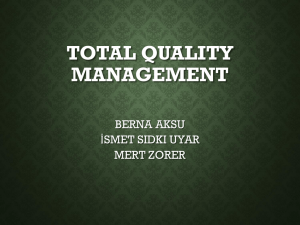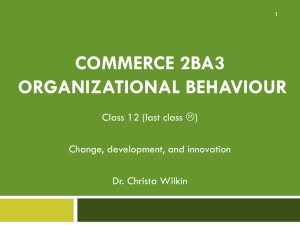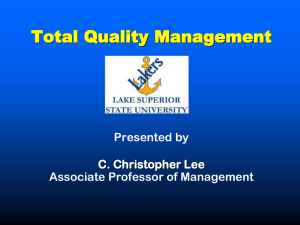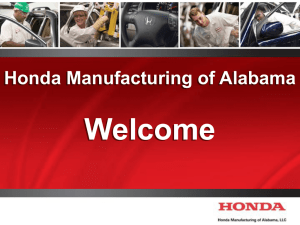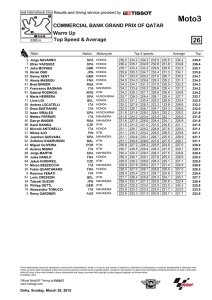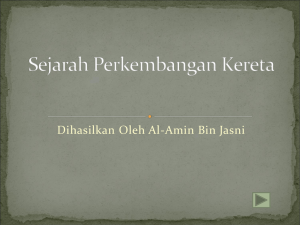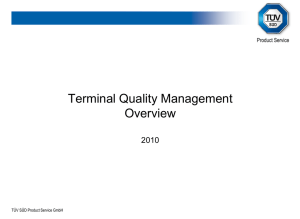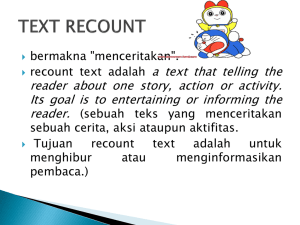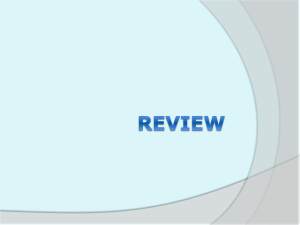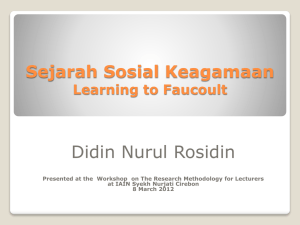Studi-Kasus
advertisement
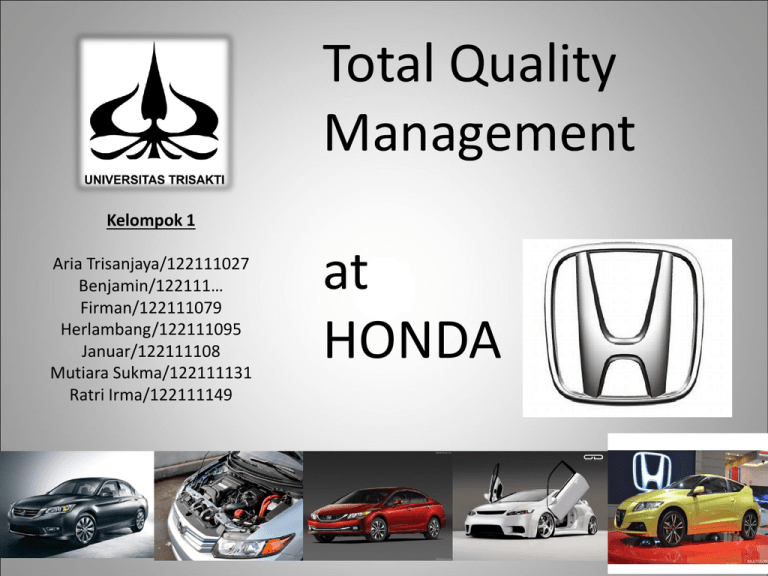
Total Quality Management Kelompok 1 Aria Trisanjaya/122111027 Benjamin/122111… Firman/122111079 Herlambang/122111095 Januar/122111108 Mutiara Sukma/122111131 Ratri Irma/122111149 at HONDA Definition of TQM An integrated effort designed to improve quality performance at every level of the organization. What’s the goal of TQM? “Do the right things right the first time, every time.” Elements of TQM ..(1) • Leadership – Top management vision, planning and support. • Employee involvement – All employees assume responsibility for the quality of their work. • Product/Process Excellence – Involves the process for continuous improvement. Elements of TQM ..(2) • Continuous Improvement – A concept that recognizes that quality improvement is a journey with no end and that there is a need for continually looking for new approaches for improving quality. • Customer Focus on “Fitness for Use” – Design quality • Specific characteristics of a product that determine its value in the marketplace. – Conformance quality • The degree to which a product meets its design specifications. Manfaat TQM P E R B A I K A N M U T U Memperbaiki Posisi persaingan Harga yg Lebih tinggi Meningkatkan Pangsa pasar Meningkatkan penghasilan Meningkatkan Keluaran yg Bebas dari kerusakan Mengurangi Biaya operasi Meningkatkan Laba Langkah-Langkah TQM 1. 2. 3. 4. 5. 6. 7. 8. 9. 10. 11. Komitmen CEO/Pimpinan Diklat untuk Top Management Membentuk Steering Committee Menetapkan visi, misi dan prinsip-prinsip Buat diagram alir proses-proses di perusahaan Fokus pada konsumen eksternal dan lakukan survey Anggap karyawan sebagai pelanggan internal Buat program pelatihan mutu untuk karyawan Bentuk Tim Perbaikan Mutu Implementasi proses perbaikan Gunakan alat – alat TQM Perkembangan TQM Deming Bound Juran Crosby Gootsch & Davids Feigenbaum Ishikawa Malcolm Baldrige National Quality Award ISO 9000 dan 14000 Metode TQM Metode W.E.Deming Siklus Deming 4 1 3 2 DEMING CYCLE • The Deming cycle, or PDSA cycle, is a continuous quality improvement model consisting of a logical sequence of four repetitive steps for continuous improvement and learning: Plan, Do, Study (Check) and Act. • The PDCA cycle is also known as the Deming Cycle, or as the Deming Wheel or as the Continuous Improvement Spiral. JURAN’S TRILOGY • an approach to cross-functional management, which is composed of three managerial processes: quality planning, quality control and quality improvement. Without change, there will be a constant waste, during change there will be increased costs, but after the improvement, margins will be higher and the increased costs get recouped. Metode Josep M. Juran • Juran’s three basic steps to progress – Mencapai perbaikan terstruktur atas dasar kesinambungan – Mengadakan program pelatihan secara luas – Membentuk komitmen dan kepemimpinan pada tingkat manajemen yang lebih tinggi Metode Philip B. Crosby Dalil Manajemen Mutu • Definisi mutu adalah sama dengan persyaratan • Sistem mutu adalah pencegahan • Kerusakan nol ( zero defect ) merupakan standar kinerja yang harus digunakan • Ukuran mutu adalah price of nonconformance Crosby’s quality vaccine • Determinasi : Sikap manajemen untuk tidak menerima proses, produk, jasa yg tidak memenuhi persyaratan, seperti reject, scrap, wrong shipment • Pendidikan • Pelaksanaan Seven Tools for TQM • • • • • • • Scatter Diagrams: Plot data on a chart – no attempt is made to classify the data or massage it Pareto Charts: Organize data on a histogram based on frequency from most prevalent to least. Help identify major causes or occurrences (80:20 rule) Check Sheets: Easy way to count frequency of occurrence by front line workers Histograms: Categorize data is cells and plot (see if any patterns emerge) Run Charts: Plot data as a function of time Cause and effects Charts: fishbone diagrams are used to identify the root causes of a problem Control Charts: are statistical tools used to determine if the variation in results is caused by common or special events Implementing TQM • Successful Implementation of TQM –Requires total integration of TQM into day-to-day operations. • Causes of TQM Implementation Failures –Lack of focus on strategic planning and core competencies. –Obsolete, outdated organizational cultures. Obstacles to Implementing TQM • Lack of a company-wide definition of quality. • Lack of a formalized strategic plan for change. • Lack of a customer focus. • Poor inter-organizational communication. • Lack of real employee empowerment. • Lack of employee trust in senior management. • View of the quality program as a quick fix. • Drive for short-term financial results. • Politics and turf issues. STUDY CASE IMPLEMENTING TOTAL QUALITY MANAGEMENT AT HONDA Latar Belakang Honda Motor Company, Ltd adalah perusahaan Publik Jepang yang dikenal sebagai perusahaan manufaktur penghasil Mobil dan Motor Honda dikenal sebagai pembuat Motor sejak 1959 dan juga dikenal sebagai penghasil terbesar mesin combustion Honda melampaui Nissan pada 2001 dan menjadi nomor dua penghasil terbesar industri mobil di Jepang. Honda saat ini adalah penghasil mobil nomor enam di dunia. Honda meraih nomor satu produksi mobil masal yang terjual di USA (Amerika Serikat) Informasi Perusahaan Revenue: US$ 107.82 billion (2011) Operating income: US$ 6.87 billion (2011) Net income: US$ 6.44 billion (2011) Total assets: US$ 139.61 billion (2011) Total equity: US$ 53.69 billion (2011) Employees:179,060 (2011) Subsidiaries: Acura, Honda Aircraft Company Jenis Produk Automobiles, Motorcycles Scooters , ATVs, Electrical Generators, Water pumps, Lawn and Garden Equipments , Tillers, Outboard motors, Robotics, Jets, Jet Engines, Thin-film solar cells Kebijakan Perusahaan Honda works to ensure that the products and services result in 3 joys: Joy for people who buy them. Joy for those who sell them and Joy for people who produce them. Quality Objective Maintain an international viewpoint , we are dedicated to supplying products of the highest efficiency yet at a reasonable price for worldwide customer satisfaction. Honda’s Quality Cycle Quality Enhancement System TQM Methodology To implement TQM, the CEO has strengthened : Customer focused viewpoint. Increased efficiency. Cost cutting efforts. Delegation of authority. Expediting daily operations. New product development. PDCA Cycle Basic principle of TQM is to bridge the gap between “Target” and “Status quo”. PDCA cycle to bridge the gap : Make initial plan. Implement the plan. Analyse the outcome. Recognise new problems and improve the process of operation. Repeat process till target is achieved. Implementing Quality Management Education In Japan, Honda offers a training curriculum divided into four courses according to in-house qualifications and the extent of individual workers' quality control responsibilities in order to improve associates' quality assurance skills. The Honda QC Basic Course (HBC), which was first offered 40 years ago, provides an example of how Honda is working to train its personnel to be leaders in improving quality. Implementing Quality Management Education In Japan, Honda offers a training curriculum divided into four courses according to in-house qualifications and the extent of individual workers' quality control responsibilities in order to improve associates' quality assurance skills. The Honda QC Basic Course (HBC), which was first offered 40 years ago, provides an example of how Honda is working to train its personnel to be leaders in improving quality. CASE SUMMARY....(1) Honda operates a TQM system. Its philosophy is to push quality back to the supplier, expecting the products to arrive defect free to Honda’s defined level. But this won’t ever stop the company from checking. “With the tolerances and the complexity of some of the components, we’ve found that some suppliers are not always able to guarantee meeting our specs – so we rely heavily on inspection. For the more critical components, particularly safety critical components, we carry out 100% inspection”. “Last season Honda recorded zero stoppages due to reliability of the chassis. The TQM system clearly contributed significantly to this. Our aim now is to maintain this record as we move forward – and the system and processes will develop in order to facilitate this aim.” CASE SUMMARY....(2) There is nothing that stands out as their single secret to quality. The secret is - they do everything -and they do it as a team The Honda philosophy stresses to be on-the-spot in the plant and see the problem, touch the part, and gain experience in the actual job, in order to effectively solve a problem. Everyone is a member of a team. At 6:30 AM each day, every associate meets with his team and team leader. The day’s work is discussed and feedback on the previous day’s quality is given. Any problems, changes, or concerns are shared during this meeting. Participation in the continuous improvement process is also structured through Quality Circles. NH Circles (NH stands for “Now Honda, New Honda, Next Honda”) are similar to quality circles in many other companies. However, at Honda they are one component of a total involvement process which they call of VIP (Voluntary Involvement Program). VIP includes a suggestion system, quality awards, and safety awards. CASE SUMMARY....(3) The NH Circle program, suggestion system, quality awards, and safety awards are all tied together with a point system. Every associate earns points by participating in any of these improvement processes. Awards include award certificates, gift certificates, Department Manager's Award, Plant Manager's Award, and President’s Award. These also result in points accumulating over your career, and these points can earn a Honda Civic (that’s for 2,500 points) Performance analysis and feedback is an important part of any total performance management system. In each of the open office areas and in each of the many conference rooms, all of the walls are literally covered with charts and graphs representing different quality and productivity performance variables, along with the charts on the wall are lists of causes or solutions to problems. At Honda, it is assumed the production associates are intelligent, skilled, and dedicated. They can, therefore, be trusted to manage the quality process. Every associate is a quality control inspector. THANK YOU


